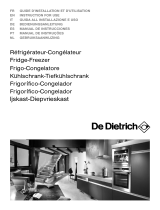4
• This appliance is intended to be used in
household and similar applications such as
- staff kitchen areas in shops, offices and other
working environments;
- farm houses and by clients in hotels, motels
and other residential type environments;
- bed and breakfast type environments.
To ensure best use of your appliance, carefully
read the operating instructions which contain
a description of the product and useful advice.
Keep these instructions for future reference.
1. After unpacking the appliance, make sure it is
not damaged and that the door closes properly.
Any damage must be reported to the dealer
within 24 hours of delivery of the appliance.
2. Wait at least two hours before switching the
appliance on, to ensure that the refrigerant
circuit is fully efficient.
3. Installation and the electrical connection must
be carried out by a qualified technician
according to the manufacturer's instructions and
in compliance with the local safety regulations.
4. Clean the inside of the appliance before using it.
BEFORE USING THE APPLIANCE
1. Packing
The packing material is 100% recyclable and bears
the recycling symbol. For disposal, comply with the
local regulations. Keep the packing materials (plastic
bags, polystyrene parts, etc.) out of the reach of
children, as they are a potential source of danger.
2. Scrapping/Disposal
The appliance is manufactured using recyclable
material.
This appliance is marked in compliance with
European Directive 2002/96/EC on Waste Electrical
and Electronic Equipment (WEEE). By ensuring the
correct disposal of this appliance, you can help
prevent potentially negative consequences for the
environment and the health of persons.
The symbol on the appliance, or on the
accompanying documents, indicates that this
appliance should not be treated as domestic waste
but must be taken to a special collection centre for
the recycling of electrical and electronic equipment.
When scrapping the appliance, make it unusable by
cutting off the power cable and removing the doors
and shelves so that children cannot easily climb
inside and become trapped.
Scrap the appliance in compliance with local
regulations on waste disposal, taking it to a special
collection centre; do not leave the appliance
unattended even for a few days, since it is a
potential source of danger for children.
For further information on the treatment, recovery
and recycling of this product, contact your
competent local office, the household waste
collection service or the shop where you purchased
the appliance.
Information:
This appliance does not contain CFCs. The
refrigerant circuit contains R134a (HFC) or R600a
(HC) (see the rating plate inside the appliance).
Appliances with Isobutane (R600a): isobutane is a
natural gas without environmental impact, but is
flammable. Therefore, make sure the refrigerant
circuit pipes are not damaged.
This product may contain Fluorinated Greenhouse
Gases covered by the Kyoto Protocol; the
refrigerant gas is inside a hermetically sealed
system.
Refrigerant gas: R134a has a Global Warming
Potential of (GWP) 1300.
Declaration of conformity
• This appliance has been designed for preserving
food and is manufactured in compliance with
Regulation (CE) No. 1935/2004.
• This appliance has been designed, manufactured
and marketed in compliance with:
- safety objectives of the "Low Voltage"
Directive 2006/95/CE (which replaces
73/23/CEE and subsequent amendments);
- the protection requirements of Directive
"EMC" 2004/108/EC.
Electrical safety of the appliance can only be
guaranteed if it is correctly connected to an
approved earthing system.
SAFEGUARDING THE ENVIRONMENT

















